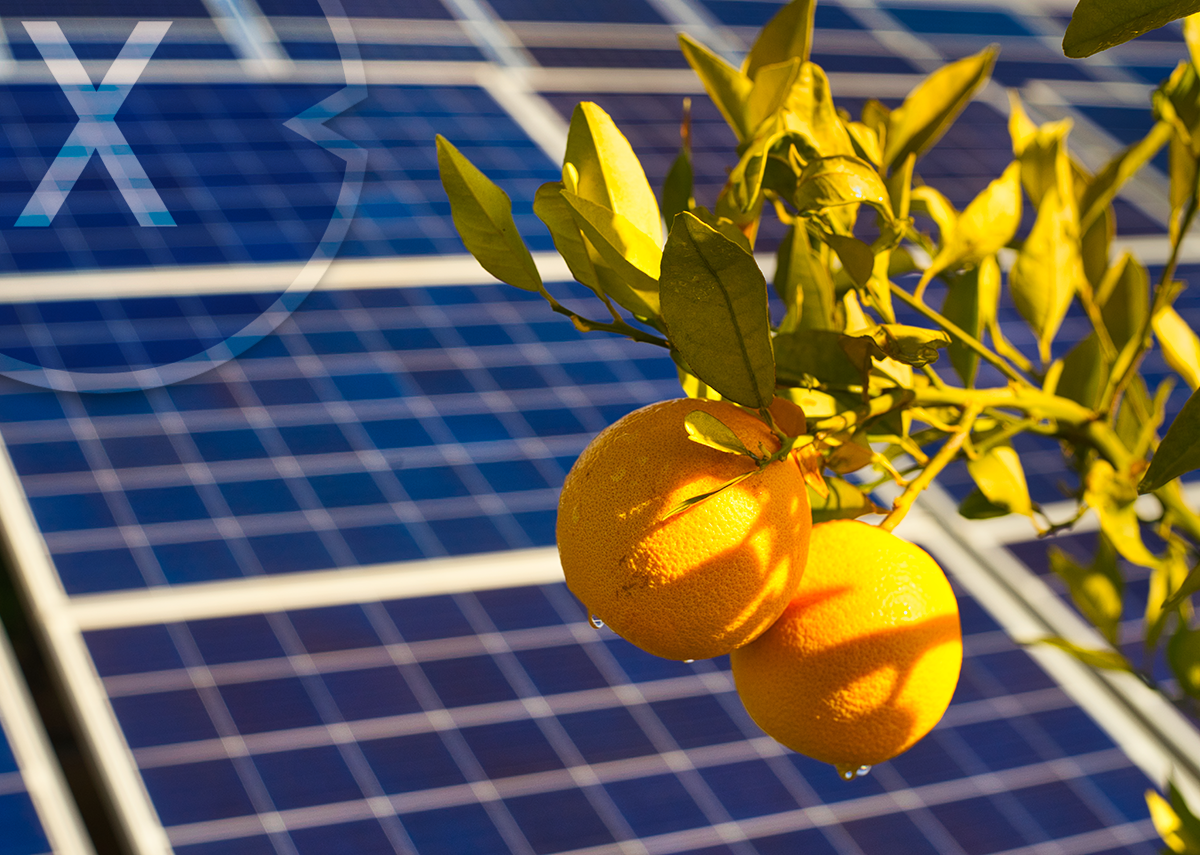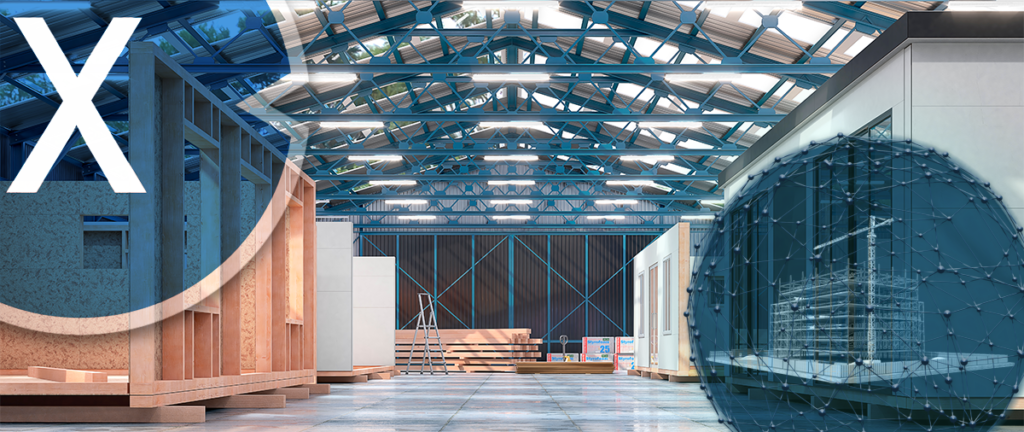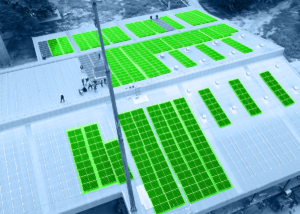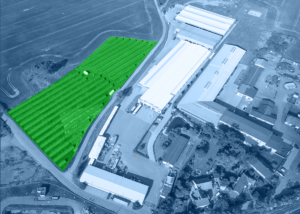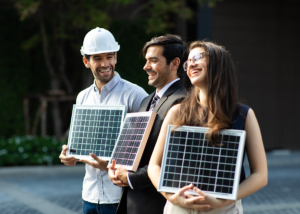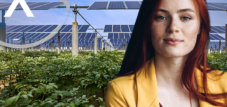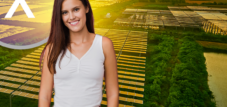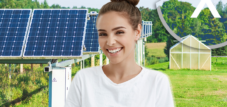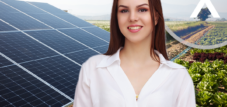Top Ten Agri-Photovoltaics (Agri-PV or AgriPV) of Companies and Companies | Metaverse Marketing
Language selection 📢
Published on: July 1, 2023 / update from: August 6, 2023 - Author: Konrad Wolfenstein
Agri-photovoltaics has a great future ahead of it, but is still waiting for a big breakthrough. Why? What are the causes?
There are several reasons why, despite its potential, agri-photovoltaics (agri-PV) is still waiting for a major breakthrough. Here are some of the main causes:
Technological challenges
The integration of photovoltaics into agricultural land requires specific technical solutions to meet the needs of both sectors. Further progress is still needed in the development of agri-PV systems to ensure maximum energy production, efficiency and long-term durability.
Complex interactions
Agri-PV systems must be carefully planned and implemented to enable optimal use of the land while not interfering with agricultural activities. The interactions between the solar systems and the plants require detailed knowledge of the agro-ecosystems and an adapted system configuration.
Acceptance in agriculture
The agricultural community is still cautious about integrating agri-PV. Further advocacy is needed to highlight the benefits and benefits of agri-PV for farmers, such as additional sources of income, improved water use efficiency or protection from the elements.
Regulatory hurdles
There are different regulations and guidelines that can influence the integration of Agri-PV. The lack of harmonization of regulations at national and international levels can complicate the development and deployment of agri-PV.
Cost factors
The cost of installing Agri-PV systems can still be higher than conventional farming practices. Although the technology becomes more cost-effective over time, progress still needs to be made to improve the economics and profitability of agri-PV.
Lack of information and awareness
Many farmers still lack knowledge and information about the possibilities and benefits of Agri-PV. Comprehensive education about the technology, how it works and its impact could lead to wider acceptance and use.
➡️ Despite these challenges, there is growing attention and interest in Agri-PV worldwide. With further research and development efforts and targeted efforts to raise awareness and promote the technology, there is potential for a significant breakthrough in the future.
Top ten companies and companies/providers (also manufacturers) Agri-Photovoltaics (Agri-PV)
AgriVoltaics GmbH
AgriVoltaics GmbH is a leading manufacturer of agri-photovoltaic solutions that specializes in the integration of solar modules into agricultural areas. Their innovative systems enable optimal use of soil and solar energy for sustainable agriculture.
SolarFarm Solutions AG
SolarFarm Solutions AG is a renowned manufacturer of agri-PV systems that were developed specifically for the requirements of agriculture. Their focus is on maximizing energy production and creating synergies between photovoltaics and agricultural activities.
CropSolar Technologies Inc.
CropSolar Technologies Inc. is a pioneer in the development and production of agri-PV solutions that enable farmers to use their agricultural land more efficiently while generating clean energy. Their holistic approach combines solar technology with agricultural know-how.
SunAgri PV Systems Ltd.
SunAgri PV Systems Ltd. is an internationally active manufacturer of agricultural photovoltaic systems. Their focus is on providing tailored solutions to farmers, enabling them to produce both food and renewable energy on the same land.
AgroSolar Power GmbH
AgroSolar Power GmbH is a specialized manufacturer of agri-PV systems that can be installed on agricultural land. Their systems offer a sustainable way to combine agriculture and energy production to increase yields.
Farmland Solar Solutions Inc.
Farmland Solar Solutions Inc. is a leading manufacturer of agri-PV systems for farms. They offer innovative solutions to maximize land use while producing clean energy to promote sustainability in agriculture.
GreenField Agri-PV Systems Ltd.
GreenField Agri-PV Systems Ltd. develops and produces state-of-the-art agri-photovoltaic solutions for agricultural applications. Their goal is to give farmers the opportunity to produce renewable energy while continuing their agricultural activities.
AgriSolar Solutions SAS
AgriSolar Solutions SAS is a French manufacturer of agri-PV systems specializing in the integration of solar panels into agricultural structures. Their tailored solutions enable farmers to diversify energy production and make their operations more sustainable.
SolarAgriTech Ltd.
SolarAgriTech Ltd. is a global company focused on the development and manufacturing of agri-photovoltaic solutions. Their products include a wide range of solar systems that are specifically optimized for use in agriculture.
AgriPV Innovations Inc.
AgriPV Innovations Inc. is an agri-PV technology manufacturer that provides innovative solutions for integrating solar panels into agricultural applications. Their products aim to increase sustainability in agriculture and provide farmers with new sources of income.

Partially transparent solar modules for Agri-PV are already in use
Partially transparent solar modules are already being used in a research facility in the “Model Region Agri-Photovoltaics Baden Württemberg”.
More about it here:
Plan your solar system for the most common applications conveniently online with our solar system planner!
With our user-friendly solar system planner you can plan your individual solar system online. Whether you need a solar system for your home, your business or for agricultural purposes, our planner offers you the opportunity to take your specific requirements into account and develop a tailor-made solution.
The planning process is simple and intuitive. You simply enter relevant information. Our planner takes this information into account and creates a tailor-made solar system that meets your needs. You can try out different options and configurations to find the optimal solar system for your application.
Additionally, you can save your plan to review later or share with others. Our customer service team is also available to answer your questions and provide support to ensure your solar system is optimally planned.
Use our solar system planner to plan your individual solar system for the most common applications and advance the transition to clean energy. Start now and take an important step towards sustainability and energy independence!

The solar system planner for the most common applications: Plan the solar system online here - Image: Xpert.Digital
More about it here:
📣 Energy-related renovation and new construction, consulting, planning and implementation for industry, retail and municipalities
Our experienced team will support you in optimizing your buildings to reduce energy consumption and promote sustainable energy use with photovoltaics. We analyze your individual needs and create tailor-made concepts that make sense both economically and ecologically. Regardless of whether it is about the energy-efficient renovation of existing buildings or the construction of new energy-efficient structures, we are at your side. Industrial facilities, retail buildings and municipal facilities can reduce their energy costs and reduce environmental impact while improving the comfort and efficiency of their buildings through our tailored solutions.
👨🏻 👩🏻 👴🏻 👵🏻 Energy-saving renovation and new construction, advice, planning and implementation for private households
We offer comprehensive support for private households in the energy-efficient renovation and construction of new buildings with photovoltaics. Our experienced team is at your side to help you advise, plan and implement your sustainable energy solutions. We analyze your energy consumption, identify savings potential and develop tailor-made concepts to improve your energy efficiency. From improving building insulation to installing energy-efficient windows and doors to installing photovoltaic and solar systems - we accompany you step by step to make your home more energy efficient and environmentally friendly. Trust in our expertise and benefit from the numerous advantages that energy renovation and the use of renewable energies offer you. Together we will create a sustainable future for your home.
Agri-PV as an innovative answer to energy and food needs
Agri-photovoltaics (agri-PV) has established itself as a promising technology that harmonizes agriculture with energy production. By integrating solar panels on agricultural land, it enables dual use of the land while contributing to sustainable energy production and food security.
Agri-PV systems offer numerous advantages for agriculture. They make optimal use of space by using agricultural land for both food production and energy production. The solar panels are placed above the plants so that they can capture sunlight while the plants continue to receive enough light for their growth. This combination of agricultural use and photovoltaics creates a win-win situation for farmers.
An important aspect of agri-PV is its contribution to sustainable energy production. The sun provides an unlimited and clean source of energy that can be used to generate electricity. By integrating solar panels into agricultural land, farmers can produce their own electricity and thus reduce their dependence on conventional energy sources. This helps reduce greenhouse gas emissions and combat climate change.
In addition, agri-PV systems offer other interesting advantages. The shading effect of solar panels can help reduce evaporation and improve water use efficiency. This is particularly important in water-scarce regions where every drop of water counts. In addition, the solar modules can also serve as protection against the elements by providing shade to the plants and protecting them from extreme heat or heavy rain.
Combining Agri-PV with modern technologies such as IoT (Internet of Things) and smart farming opens up even more possibilities. By integrating sensors into the Agri-PV systems, farmers can monitor the health of crops and environmental conditions. This data can be used to optimize irrigation, fertilization and general agricultural practices. Combining Agri-PV with these technologies enables more precise and efficient agriculture.
Although agri-PV is a promising concept, there are still challenges that need to be overcome. Technological development and optimization of Agri-PV systems is crucial to maximize energy production while ensuring that agricultural activities are not affected. In addition, further investments and support measures are needed to promote the acceptance and spread of agri-PV among farmers and society as a whole.
➡️ Agri-photovoltaics (Agri-PV) is a promising and innovative answer to increasing energy and food needs. By using the sun as a partner in agriculture, we can promote more sustainable and efficient agriculture, contributing to both food security and energy supply. With further advances in technology and support from politics and society, Agri-PV could play a key role in sustainable agriculture.
Farming 2.0: Agri-PV as the key to sustainable food production
Agri-photovoltaics (agri-PV) has the potential to revolutionize the way we produce food. By harnessing solar energy to generate electricity while managing agricultural land, Agri-PV offers an innovative answer to the challenges of sustainable food production in the 21st century.
The integration of agri-PV into agriculture enables dual use of limited land. The solar panels are placed above the plants to capture sunlight and convert it into electrical energy. At the same time, they allow the plants to receive sufficient light for their growth. This combination of photovoltaics and agriculture creates a symbiotic relationship in which the sun acts as a partner in agriculture.
A key advantage of Agri-PV is sustainable energy production. The sun provides a clean and renewable energy source that can be used to generate electricity. By integrating solar panels on agricultural land, farmers can produce their own electricity and reduce their dependence on conventional energy resources. This leads to a reduction in greenhouse gas emissions and helps combat climate change.
In addition, Agri-PV offers other fascinating possibilities for sustainable food production. The shading effect of solar panels can help reduce evaporation and improve water use efficiency. This is particularly important in areas with limited water resources, as every drop of water counts. The solar panels also provide some protection from extreme weather conditions such as heat or heavy rain by providing shade to the plants and reducing their sensitivity to environmental influences.
Agri-PV can also contribute to increased agricultural efficiency. By integrating sensors and IoT technologies into the facilities, farmers can monitor crop health and environmental conditions in real time. This allows for more precise control of irrigation, fertilization and general agricultural practices. The data collected by the sensors can be used to optimize cultivation and maximize crop yields.
In addition, Agri-PV offers the opportunity to promote the cultivation of crops in urban areas. By integrating solar panels on roofs, facades and vertical structures, urban farmers can not only generate clean electricity but also grow fresh produce on site. This reduces transportation costs and gives consumers access to fresh, healthy food.
Despite the promising potential of Agri-PV, there are still challenges to be overcome. The cost of installing and operating Agri-PV systems needs to be further reduced to enable wider acceptance and application. Developing appropriate farming practices and varieties suitable for growing under solar panels also requires further research and collaboration between agriculture and energy experts.
➡️ Agri-PV is a groundbreaking technology that uses the sun as a partner in agriculture, thereby contributing to sustainable food production. Farming 2.0 with Agri-PV not only offers ecological benefits such as reducing greenhouse gas emissions, but also economic benefits for farmers through the production of renewable energy. It is an innovative response to the challenges of agriculture in the 21st century and a step towards a sustainable and future-proof food supply.
Breakthrough on the horizon: Partially transparent agri-photovoltaics - the game changer for agriculture
The sun as a partner in agriculture: Breakthrough on the horizon: Partially transparent agri-photovoltaics – the game changer for agriculture
Agri-photovoltaics (agri-PV) has already made great strides in combining solar energy and agriculture, but now a breakthrough is emerging that has the potential to revolutionize agriculture. Semi-transparent Agri-PV modules are available as game changers to make the sun a partner in agriculture and thus take sustainable food production to a new level.
The integration of semi-transparent Agri-PV modules into agricultural areas opens up new possibilities for the simultaneous use of solar energy and agricultural production. These special modules are designed to both transmit light for plant photosynthesis and convert solar energy into electrical power. This means farmers no longer have to choose between using the land to grow food and producing renewable energy – they can do both at the same time.
The game changer lies in the semi-transparent properties of the Agri-PV modules. By using special materials and technologies, the light is controlled in such a way that it benefits both the plants and the photovoltaic cells. This allows the plants to receive sufficient sunlight for their growth, while at the same time the solar panels generate enough energy to power the farm or even feed it into the grid.
The advantage of partially transparent Agri-PV is obvious. Farmers can increase their crop yields while producing sustainable energy. This represents a significant step towards sustainable agriculture that can both meet the increasing food needs of the growing population and address the challenges of climate change. At the same time, the use of renewable energy reduces the carbon footprint of farms and contributes to reducing greenhouse gas emissions.
Partially transparent Agri-PV modules also offer other fascinating possibilities. Because they can filter sunlight, they provide some protection from extreme heat, heavy rain, or hail. This helps plants stay healthy and improve their crop quality. In addition, these modules can provide shade, which is particularly advantageous in regions with intense sunlight. The shade effect can help reduce evaporation and optimize water use by plants.
However, the semi-transparent Agri-PV technology still has challenges to overcome. The efficiency of the modules needs to be further improved to ensure maximum power generation and crop yield. The development of cultivation recommendations and varieties that are optimal for cultivation under the partially transparent modules also requires further research and adjustments.
Despite these challenges, the prospects for semi-transparent agri-photovoltaics are promising. The technology offers an innovative solution to use the sun as a partner in agriculture and make agriculture more sustainable and efficient. If farmers are able to produce food and generate renewable energy at the same time, they can play an important role in combating climate change and creating a sustainable future.
➡️ The breakthrough of semi-transparent agri-PV is on the horizon and promises to revolutionize agriculture. It is time to see the sun as a partner to agriculture and recognize this innovative technology as a game changer for agriculture. The future of sustainable food production lies in the hands of farmers who harness the power of the sun to ensure our food security while contributing to energy supplies.
Future technology for sales & marketing of agri-photovoltaics (agri-PV) with Metaverse and XR technologies
A future technology for sales and marketing of agri-photovoltaics (agri-PV) could be the integration of Metaverse and XR technologies.
Virtual product presentation
By using XR technologies such as Virtual Reality (VR), potential customers can virtually explore and experience Agri-PV systems. You can visualize the systems in 3D, try out different configurations and get a realistic impression of their size, performance and integration into agricultural environments.
Interactive training and training simulations
Metaverse platforms make it possible to conduct training and training simulations in virtual environments. Farmers, sales representatives or installers can experience realistic scenarios that help them understand the potential of Agri-PV, learn the installation process and grasp the benefits of the technology.
Virtual farm tours
With XR technologies, customers can take virtual tours of real farms where agri-PV systems are already implemented. You can experience first-hand the integration of solar panels into farms, observe the energy output and receive information about the positive impact on crops and sustainability.
Data visualization and performance analysis
By using XR technologies, complex data about the energy yield, efficiency and harvest results of agri-PV systems can be visualized and presented interactively. Customers can view the data in real time and simulate different scenarios to better understand how Agri-PV can support their farms.
Virtual community platforms
Metaverse platforms offer the opportunity to build virtual communities where interested parties, farmers, professionals and manufacturers of agri-PV can meet and exchange ideas. By creating a virtual community, knowledge, experiences and best practices can be shared, discussions can be held and potential business opportunities can be discovered.
➡️ Integrating Metaverse and XR technologies into the Agri-PV sales and marketing process can provide an interactive and immersive experience that improves potential customers' understanding, adoption and purchasing decisions. It enables more effective communication of the benefits and opportunities of Agri-PV, thereby driving market development.
What are the XR technologies?
XR technologies, also referred to as extended reality, encompass a variety of immersive technologies, including virtual reality (VR), augmented reality (AR), and mixed reality (MR). Each of these technologies offers different experiences and applications. Here is an explanation for each technology:
Virtual Reality (VR)
Virtual Reality creates a fully computer-generated virtual environment that completely immerses the user in an alternative reality. The user usually wears a VR headset, which immerses them visually and sometimes acoustically in an immersive 3D environment. In VR, the user can interact with objects and environments and move freely in the virtual world. VR is widely used for simulations, gaming, virtual training, and immersive experiences.
Augmented Reality (AR)
Augmented reality superimposes computer-generated content, such as graphics, text or 3D objects, onto the user's real environment. AR is typically displayed on mobile devices such as smartphones or tablets, which use a camera to capture the environment and overlay virtual content on top. Users can use AR applications to overlay additional information or virtual objects into their real surroundings. AR has applications in areas such as gaming, navigation, retail, education and industry.
Mixed Reality (MR)
Mixed reality combines elements of virtual and augmented reality to seamlessly integrate digital content into the user's real environment. MR technologies capture the user's physical environment and allow them to interact with virtual objects integrated into the real world. Unlike AR, MR environments respond to the user's movements and interactions in real time, allowing for a more immersive and realistic experience. MR has applications in areas such as design, architecture, engineering and industrial manufacturing.
Extended Reality (XR)
Extended Reality is an umbrella term that includes all three technologies – virtual reality, augmented reality and mixed reality. XR represents an extension of the real world through computer-generated content, allowing users to immerse themselves in immersive and interactive environments. XR technologies offer businesses and users a wide range of applications, creating new ways to communicate, train, entertain and sell.
➡️ Overall, XR technologies offer an exciting future perspective for interaction with digital content and the integration of virtual and real worlds. They have the potential to fundamentally change the way we work, entertain and communicate.
Metaverse? What is that?
The Metaverse is a concept that has gained increased attention in recent years and is playing an increasingly important role in technological development. It refers to an augmented digital reality in which virtual worlds, augmented reality (AR) and virtual reality (VR) fuse together to create an immersive and interactive experience. The Metaverse can be viewed as a shared virtual space where people can interact, transact, learn, work and express their creativity.
In particular, the Business Metaverse refers to the application of the Metaverse concept in a business context. It opens up new opportunities for companies and organizations to interact with customers, partners and employees and to make business processes more efficient. By integrating XR technologies such as AR, VR and MR into the business metaverse, companies can digitally expand their presence and interactions and find new innovative ways to showcase products and services, increase sales and build customer relationships.
The connection between the Metaverse and XR technologies is close and reciprocal. XR technologies are essential parts of the Metaverse as they enable the immersive and interactive experiences required to immerse oneself in virtual worlds and interact with digital content. They enable users to move around a digital environment, interact with virtual objects and communicate with other users. XR technologies play a critical role in creating immersive presentations, training, virtual meetings and virtual shopping experiences in the business metaverse.
The Business Metaverse offers companies a number of advantages and opportunities:
global presence
Through the Business Metaverse, companies can expand their presence across geographic boundaries. You can create business locations, retail spaces or training rooms in virtual environments and provide access to customers, partners and employees worldwide. This allows companies to reach global audiences and expand access to their products and services.
Virtual product presentations
The Business Metaverse offers companies the opportunity to present their products and services in virtual environments. Through XR technologies, customers can visualize the products in 3D, view them from different angles and even interact with them interactively. Companies can create virtual showrooms, product demonstrations or immersive presentations to provide customers with an immersive experience and support the sales process.
Virtual meetings and collaboration
The Business Metaverse enables companies to organize virtual meetings and collaboration over long distances. Employees can meet in virtual meeting rooms, give presentations, work on projects together and exchange ideas as if they were physically in one place. This promotes efficiency, saves travel costs and enables teams to work together seamlessly, regardless of their geographical location.
Virtual training and continuing education
The Business Metaverse offers companies the opportunity to conduct training and continuing education programs in virtual environments. Employees can complete interactive training, simulate complex processes or learn new skills in safe virtual environments. This enables effective knowledge transfer and ensures a high level of participant participation.
Customer interaction and personalization
Through the Business Metaverse, companies can create personalized customer interactions. Using XR technologies, customers can create virtual avatars and interact with companies in virtual environments. Companies can offer personalized recommendations, virtual consulting services or interactive shopping experiences to better understand customer needs and offer customized solutions.
➡️ The Business Metaverse is an exciting future technology for sales & marketing that opens up new opportunities for companies to reach customers, strengthen their brand and increase business success. By combining XR technologies with the Metaverse concept, companies can create immersive and interactive experiences that delight customers and leave a lasting impression. The business metaverse is expected to continue to grow in importance in the coming years, playing an increasingly larger role in the way companies interact with customers and partners.
- Warehouses, production halls and industrial halls with their own power source from a photovoltaic roof system - Image: NavinTar|Shutterstock.com
- Industrial plant with its own power source from an outdoor photovoltaic system - Image: Peteri|Shutterstock.com
- Plan solar systems with photovoltaic solutions for freight forwarding and contract logistics
- B2B solar systems and photovoltaic solutions & advice
- Plan photovoltaics for warehouses, commercial halls and industrial halls
- Industrial plant: Plan a photovoltaic open-air system or open-space system
- Plan solar systems with photovoltaic solutions for freight forwarding and contract logistics
- B2B solar systems and photovoltaic solutions & advice
Agricultural solar: With Xpert.Solar your individual agricultural photovoltaics as well as manufacturer and provider advice
I would be happy to serve as your personal advisor.
You can contact me by filling out the contact form below or simply call me on +49 89 89 674 804 (Munich) .
I'm looking forward to our joint project.
Xpert.Digital – Konrad Wolfenstein
Xpert.Digital is a hub for industry with a focus on digitalization, mechanical engineering, logistics/intralogistics and photovoltaics.
With our 360° business development solution, we support well-known companies from new business to after sales.
Market intelligence, smarketing, marketing automation, content development, PR, mail campaigns, personalized social media and lead nurturing are part of our digital tools.
You can find out more at: www.xpert.digital – www.xpert.solar – www.xpert.plus



